两个APK间通过AIDL进行binder通信
参考文章:两个APK间通过AIDL进行binder通信
server端
创建一个空项目,在项目里面添加如下内容
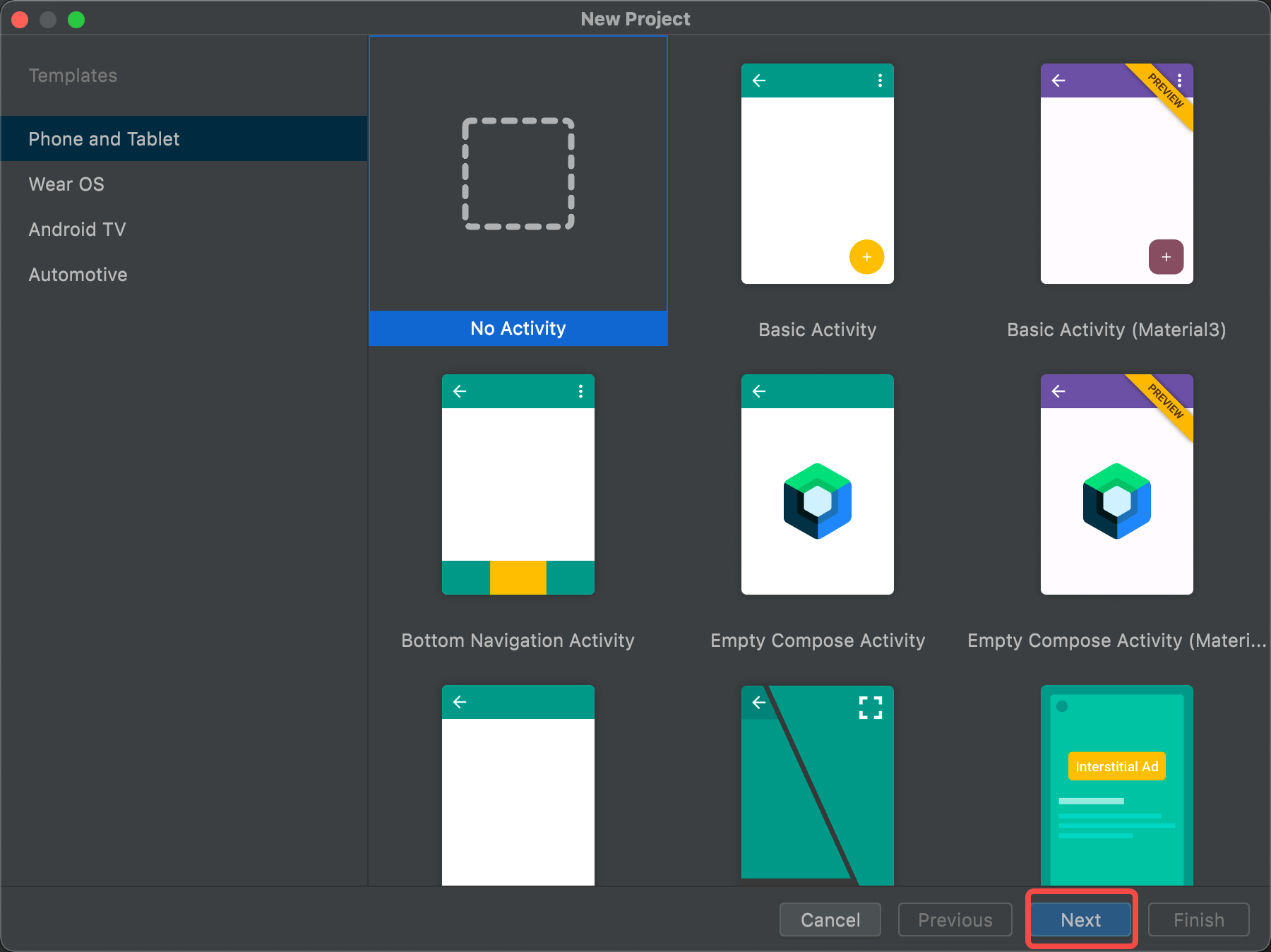
//MyService.java package com.example.binderserver; import android.app.Service; import android.content.Intent; import android.os.IBinder; import android.os.RemoteException; public class MyService extends Service { private class MyBinder extends MyInterface.Stub { @Override public int add(int a, int b) throws RemoteException { return a + b; } } private IBinder mBinder = new MyBinder(); public MyService() { } @Override public IBinder onBind(Intent intent) { return mBinder; } }
// MyInterface.aidl package com.example.binderserver; // Declare any non-default types here with import statements interface MyInterface { /** * Demonstrates some basic types that you can use as parameters * and return values in AIDL. */ int add(int a, int b); }
aidl文件的创建如下(aidl文件并不会创建在你指定的目录,AS会为aidl文件生成专门的目录):
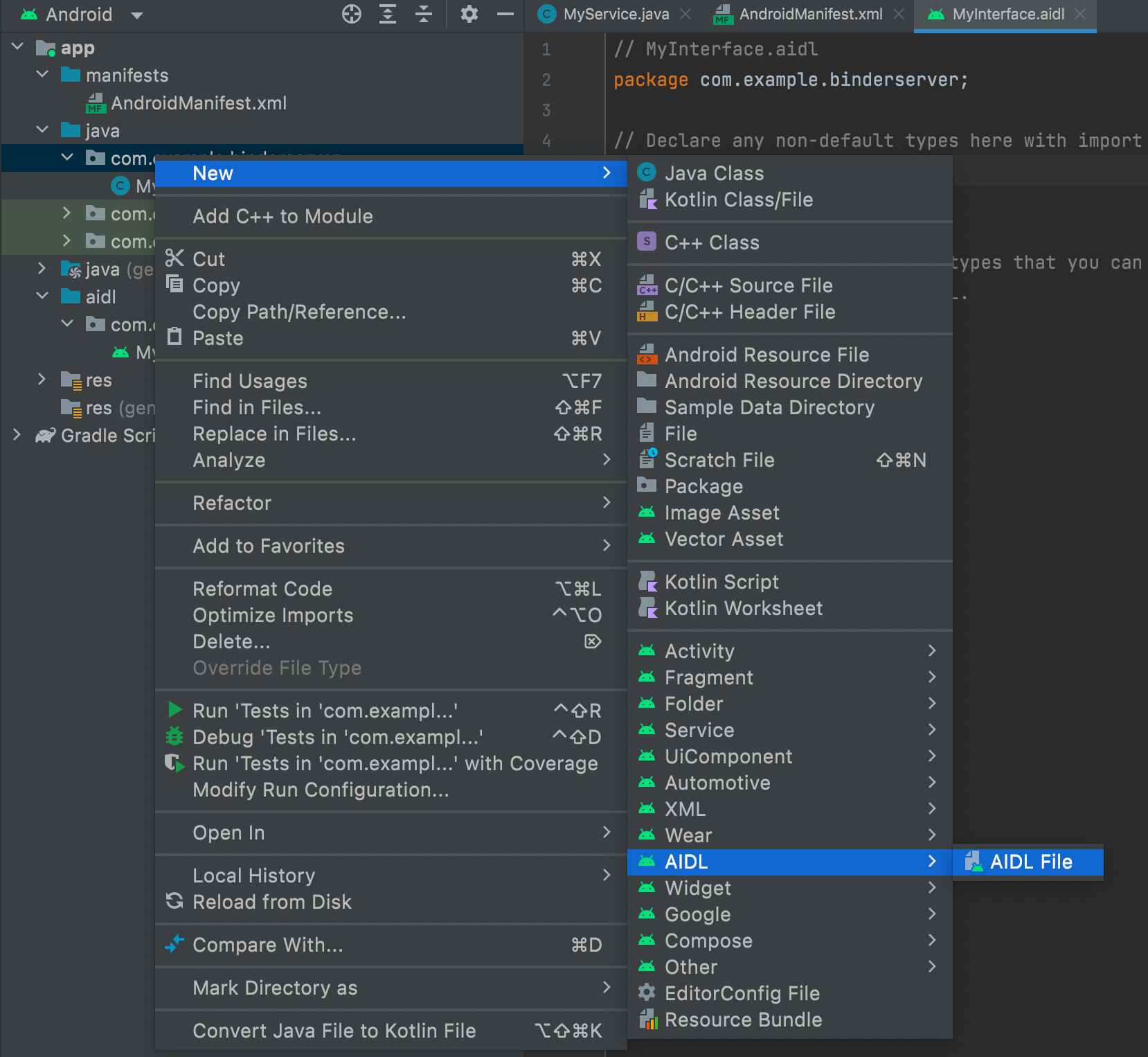
//AndroidManifest.xml <?xml version="1.0" encoding="utf-8"?> <manifest xmlns:android="http://schemas.android.com/apk/res/android" xmlns:tools="http://schemas.android.com/tools" package="com.example.binderserver"> <application android:allowBackup="true" android:dataExtractionRules="@xml/data_extraction_rules" android:fullBackupContent="@xml/backup_rules" android:icon="@mipmap/ic_launcher" android:label="@string/app_name" android:roundIcon="@mipmap/ic_launcher_round" android:supportsRtl="true" android:theme="@style/Theme.BinderServer" tools:targetApi="31" > <service android:name=".MyService" android:enabled="true" android:exported="true"> <intent-filter> <action android:name="com.example.binderserver.MyService"/> </intent-filter> </service> </application> </manifest>
需要注意的是server没有activity,只有service,所以我们在配置工程的时候配置没有activity启动
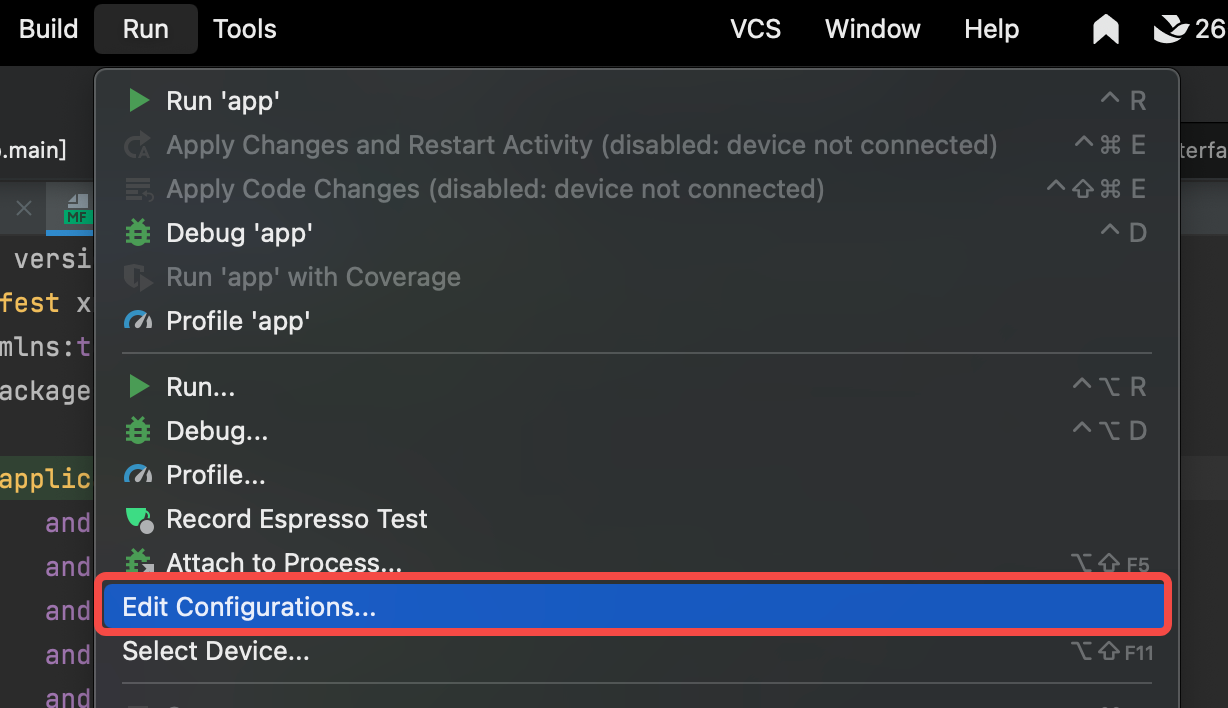

目录结构如下:
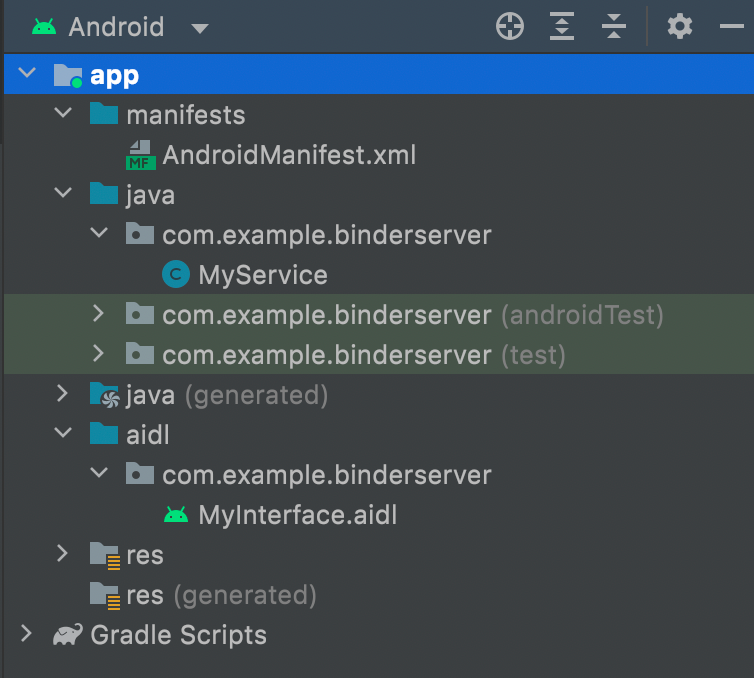
Client端
创建项目
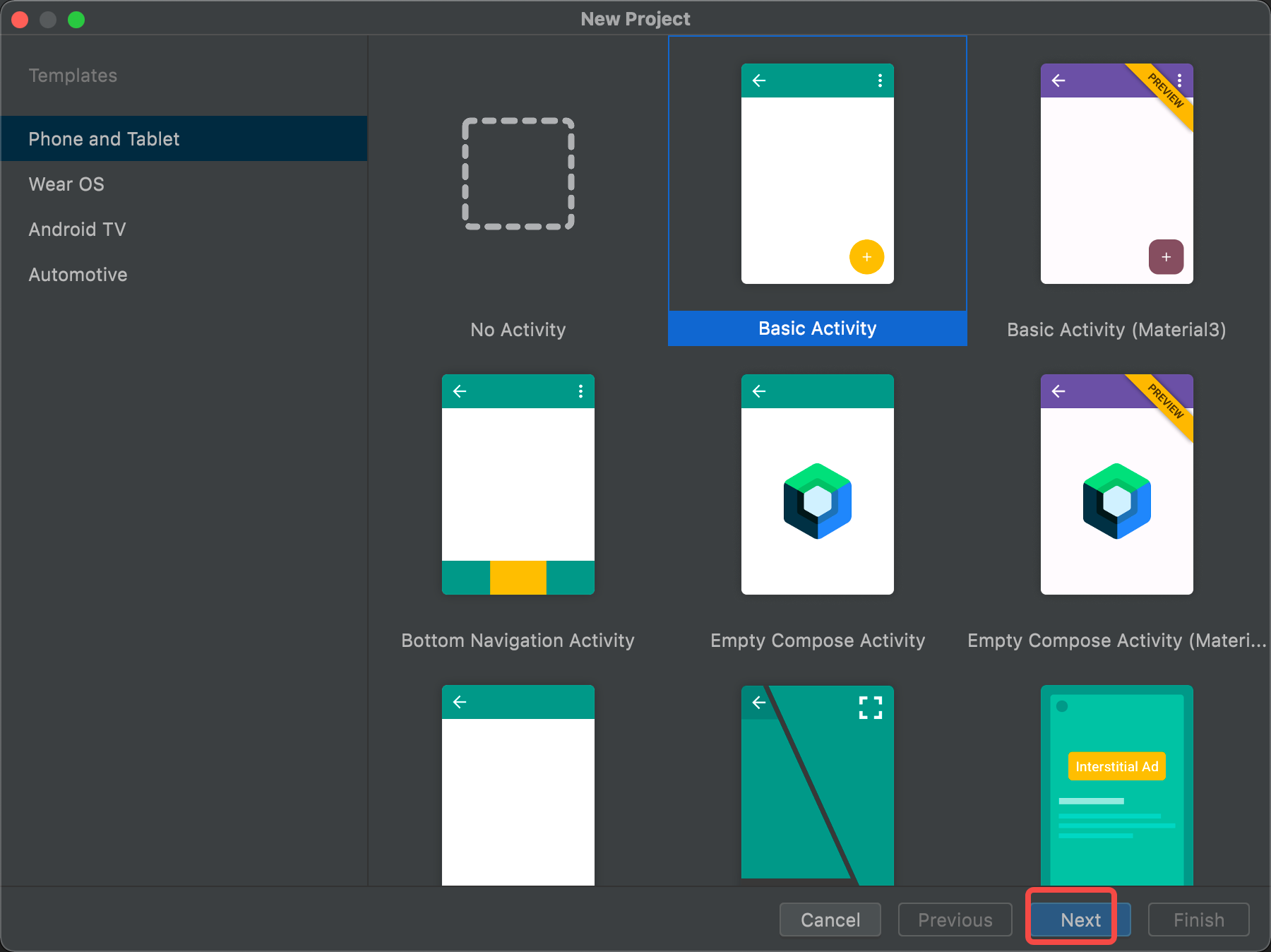
//MainActivity.java package com.example.binderclient; import android.content.ComponentName; import android.content.Context; import android.content.Intent; import android.content.ServiceConnection; import android.os.Bundle; import com.google.android.material.snackbar.Snackbar; import androidx.appcompat.app.AppCompatActivity; import android.os.IBinder; import android.os.RemoteException; import android.util.Log; import android.view.View; import androidx.navigation.NavController; import androidx.navigation.Navigation; import androidx.navigation.ui.AppBarConfiguration; import androidx.navigation.ui.NavigationUI; import com.example.binderclient.databinding.ActivityMainBinding; import android.view.Menu; import android.view.MenuItem; import android.widget.Button; import com.example.binderserver.MyInterface; public class MainActivity extends AppCompatActivity { private String TAG = "QMH"; private AppBarConfiguration appBarConfiguration; private ActivityMainBinding binding; private MyInterface myInterface; Button button2; private ServiceConnection mConnection = new ServiceConnection() { @Override public void onServiceConnected(ComponentName componentName, IBinder iBinder) { Log.i(TAG, "onServiceConnection"); myInterface = MyInterface.Stub.asInterface(iBinder); try { int result = myInterface.add(2, 3); Log.i(TAG, "result1111:" + result); } catch (RemoteException e) { e.printStackTrace(); } } @Override public void onServiceDisconnected(ComponentName componentName) { Log.i(TAG, "onServiceDisconnected"); } }; @Override protected void onCreate(Bundle savedInstanceState) { super.onCreate(savedInstanceState); binding = ActivityMainBinding.inflate(getLayoutInflater()); setContentView(binding.getRoot()); setSupportActionBar(binding.toolbar); NavController navController = Navigation.findNavController(this, R.id.nav_host_fragment_content_main); appBarConfiguration = new AppBarConfiguration.Builder(navController.getGraph()).build(); NavigationUI.setupActionBarWithNavController(this, navController, appBarConfiguration); Intent intent = new Intent("com.example.binderserver.MyService"); intent.setPackage("com.example.binderserver"); boolean b = bindService(intent, mConnection, Context.BIND_AUTO_CREATE); Log.i(TAG, "onCreate : " + b ); binding.fab.setOnClickListener(new View.OnClickListener() { @Override public void onClick(View view) { Snackbar.make(view, "Replace with your own action", Snackbar.LENGTH_LONG) .setAction("Action", null).show(); } }); button2 = (Button) findViewById(R.id.button); button2.setOnClickListener(new View.OnClickListener(){ @Override public void onClick(View view) { try { int result = myInterface.add(2, 3); Log.i(TAG, "result1111:" + result); } catch (RemoteException e) { Log.i(TAG, "111111111" + e.toString()); } } }); } @Override public boolean onCreateOptionsMenu(Menu menu) { // Inflate the menu; this adds items to the action bar if it is present. getMenuInflater().inflate(R.menu.menu_main, menu); return true; } @Override public boolean onOptionsItemSelected(MenuItem item) { // Handle action bar item clicks here. The action bar will // automatically handle clicks on the Home/Up button, so long // as you specify a parent activity in AndroidManifest.xml. int id = item.getItemId(); //noinspection SimplifiableIfStatement if (id == R.id.action_settings) { return true; } return super.onOptionsItemSelected(item); } @Override public boolean onSupportNavigateUp() { NavController navController = Navigation.findNavController(this, R.id.nav_host_fragment_content_main); return NavigationUI.navigateUp(navController, appBarConfiguration) || super.onSupportNavigateUp(); } }
//activity_main.xml 就只多添加了一个按钮button <?xml version="1.0" encoding="utf-8"?> <androidx.coordinatorlayout.widget.CoordinatorLayout xmlns:android="http://schemas.android.com/apk/res/android" xmlns:app="http://schemas.android.com/apk/res-auto" xmlns:tools="http://schemas.android.com/tools" android:layout_width="match_parent" android:layout_height="match_parent" tools:context=".MainActivity"> <com.google.android.material.appbar.AppBarLayout android:layout_width="match_parent" android:layout_height="wrap_content" android:theme="@style/Theme.BinderClient.AppBarOverlay"> </com.google.android.material.appbar.AppBarLayout> <include layout="@layout/content_main" /> <com.google.android.material.floatingactionbutton.FloatingActionButton android:id="@+id/fab" android:layout_width="wrap_content" android:layout_height="wrap_content" android:layout_gravity="bottom|end" android:layout_marginEnd="@dimen/fab_margin" android:layout_marginBottom="16dp" app:srcCompat="@android:drawable/ic_dialog_email" /> <Button android:id="@+id/button" android:layout_width="wrap_content" android:layout_height="wrap_content" android:text="Button11111" /> <androidx.appcompat.widget.Toolbar android:id="@+id/toolbar" android:layout_width="match_parent" android:layout_height="?attr/actionBarSize" android:background="?attr/colorPrimary" app:popupTheme="@style/Theme.BinderClient.PopupOverlay" /> </androidx.coordinatorlayout.widget.CoordinatorLayout>
//注意添加queries Android 11 之后启动service需要权限 //AndroidManifest.xml <?xml version="1.0" encoding="utf-8"?> <manifest xmlns:android="http://schemas.android.com/apk/res/android" xmlns:tools="http://schemas.android.com/tools" package="com.example.binderclient"> <queries> <package android:name="com.example.binderserver" /> <package android:name="com.example.binderclient" /> </queries> <application android:allowBackup="true" android:dataExtractionRules="@xml/data_extraction_rules" android:fullBackupContent="@xml/backup_rules" android:icon="@mipmap/ic_launcher" android:label="@string/app_name" android:roundIcon="@mipmap/ic_launcher_round" android:supportsRtl="true" android:theme="@style/Theme.BinderClient" tools:targetApi="31"> <activity android:name=".MainActivity" android:exported="true" android:label="@string/app_name" android:theme="@style/Theme.BinderClient.NoActionBar"> <intent-filter> <action android:name="android.intent.action.MAIN" /> <category android:name="android.intent.category.LAUNCHER" /> </intent-filter> </activity> </application> </manifest>
把server端的aidl文件移动过来,注意包名,类名,接口名,及其里面的代码需要保证完全一致,否则会报错
// MyInterface.aidl package com.example.binderserver; // Declare any non-default types here with import statements interface MyInterface { /** * Demonstrates some basic types that you can use as parameters * and return values in AIDL. */ int add(int a, int b); }
目录结构如下:

异常
异常1
Client端启动Server端之后调用add方法报错:Binder invocation to an incorrect interface
当进行AIDL跨进程通讯时,如果抛出 Binder invocation to an incorrect interface ,则主要是因为2种情况。
1、最普遍的,客户端 VS 服务端 的AIDL必须保证完全一样,包括包名,类名,接口名,及其里面的代码。否则会抛出以上异常
2、如果第一条符合,则检查下调用的服务是否正确,如果调用的服务不一致或者 服务中返回给客户端的Binder不是客户端想要的,则也会抛出以上异常。
3、如果以上2点,确定没问题,请参考第2点,必定是客户端和服务端的AIDL某处相关代码不一致导致。
我出现这个问题是因为我在Client端创建的aidl文件,然后把server端的aidl文件内容拷贝过来。但是两个文件的包名是不一样的,所以出错了
异常2
通过am startservice -n 启动server端的时候报错。

这好像不是一个异常,服务好像就是启动不起来。我把client端打开之后,server端就可以起来了。
异常3
AppsFilter: interaction: ***BLOCKED 错误
//启动client的时候出现下面log,表示无法启动server端 03-20 16:52:31.209 1371 2038 I AppsFilter: interaction: PackageSetting{524890e com.example.binderclient/10088} -> PackageSetting{5ebfadb com.example.binderserver/10087} BLOCKED 03-20 16:52:31.209 1371 2038 W ActivityManager: Unable to start service Intent { act=com.example.binderserver.MyService pkg=com.example.binderserver } U=0: not found
在 Android 11 ® 上有时跨APP 访问别的进程里面的数据,或者绑定服务的时候会出现这样的问题
这是 Android 11 增加了安全限制,需要在AndroidManifest.xml清单文件中加入query权限申请,才能检测到手机上安装的三方应用包安装状态
解决办法:
1) 降低SDK版本
修改build.gradle,降低SDK版本为Android 29
或者
2)修改目标软件可见性
在AndroidManifest.xml中添加queries标签声明需要用到的应用包名
<manifest package="com.example.test"> <queries> <package android:name="com.example.service" /> <package android:name="com.example.client" /> </queries> ... </manifest>
















【推荐】国内首个AI IDE,深度理解中文开发场景,立即下载体验Trae
【推荐】编程新体验,更懂你的AI,立即体验豆包MarsCode编程助手
【推荐】抖音旗下AI助手豆包,你的智能百科全书,全免费不限次数
【推荐】轻量又高性能的 SSH 工具 IShell:AI 加持,快人一步
· 10年+ .NET Coder 心语 ── 封装的思维:从隐藏、稳定开始理解其本质意义
· 地球OL攻略 —— 某应届生求职总结
· 提示词工程——AI应用必不可少的技术
· Open-Sora 2.0 重磅开源!
· 周边上新:园子的第一款马克杯温暖上架
2019-03-20 简单数学题(杭电)